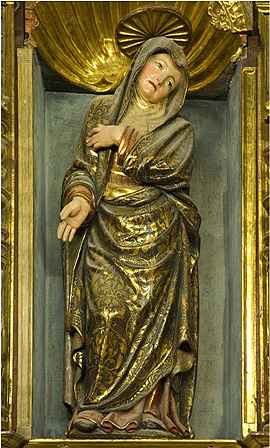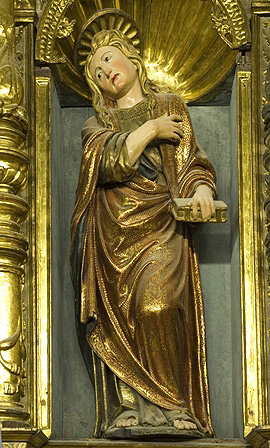The piece of the month of July 2011
THE ALTARPIECE OF THE CRUCIFIED OF THE MUSEUM OF THE DECANAL PALACE OF TUDELA
Jesús Criado Mainar
University of Zaragoza
One of the keys to the introduction of the Renaissance in Tudela and the Ribera region was the early arrival in this territory of French sculptors and carvers, among whom the Norman Esteban de Obray (doc. 1519-1551, †1551) played a fundamental role. As documented by José R. Castro, this craftsman from Saint-Omer, in Artois, participated in the work of the new choir stalls (around 1517-1522) of the collegiate church of Santa María and is traditionally credited with the magnificent "Romanesque" grille of wood and iron (around 1525) that closes the enclosure. He was also involved in the project of the great altarpiece of the parish of San Juan Bautista de Cintruénigo (1525, 1529-1530 and later) where he may have collaborated with his compatriot Gabriel Joly (doc. 1514-1536, †1536) because, as revealed by a agreement of 1525 published by Manuel Abizanda, everything suggests that the painter Pedro de Aponte (doc. 1502-1530, †1530), at whose position the Cirbonero altarpiece was located, had previously arranged for the collaboration of this great Picardy-born imager based in Zaragoza to execute the sculptural elements of the altarpiece.
Esteban de Obray and Gabriel Joly coincided around the same time in Calatayud, a city where the former had gone in 1525 at the request of Pedro Villalón, dean of the churches of Tudela and Calatayud, to make the alabaster façade of the collegiate church of Santa María la Mayor (1525-1528) in the company of Juan de Talavera from Santiago de Compostela. The association of Obray and Joly in the bilbilitana region would be specified in the precious main altarpieces of the parishes of the Virgin of the Castle of Aniñón (around 1525-1530) and Santa María de Olvés (around 1530-1532), although the latter is incompletely preserved due to the robbery it suffered in 1989.
There is no doubt that this professional link would favor Gabriel Joly's participation in other projects in Tudela, since, as José R. Castro himself reported, in 1537, in the final stretch of his degree program, the Picard contracted a bust of St. Stephen for the parish of St. George. However, the piece that best illustrates the cooperation of these two Gallic professionals is the altarpiece of the Crucifixion of the church of San Nicolás -like the previous work, exhibited in the Museo del Palacio Decanal-, a set that we date around 1525-1530 but about whose realization we lack data.

Altarpiece of the Crucified Christ from the church of San Nicolás de Tudela (1525-1530).
Dean Museum of Tudela
Tomás Biurrun arbitrarily identified this set with another lost one that was dedicated to San Bartolomé and that, according to the documentary news located by José R. Castro, was commissioned by the chaplain Martín de Sesma in 1564-1565 to the sculptor Domingo Segura and the painter Martín de Tapia. The pastoral visit sent to the temple in June 1594 by Bishop Pedro Cerbuna (1585-1597) corroborates, in effect, the patronage of the Sesma family over the altarpiece of San Bartolomé and demonstrates that it has nothing to do with the one that now occupies us, owned at that time by the Serralta family, who by 1573 had erected a new chapel in the church in which our work was rearranged without us being able to determine the identity of its true patrons.
The altarpiece of the Crucified is a beautiful set of imagery that houses in the bank a group of Santa Ana, the Virgin and the Child flanked in the lateral houses by seated images of the evangelists San Lucas and San Mateo. The noble zone, integrated by three venerated niches among which the central one is of superior width and height, is presided by Christ crucified in company of Gestas and Dimas between magnificent sculptures of the Dolorosa and San Juan evangelist. On the lateral streets there are as many square houses with holy martyrs among which only the identification of Saint Catherine of Alexandria is viable, since her companion has lost the corresponding iconographic attribute. The central street culminates in a great flat veneration with a relief of God the Father between triangular pediments with busts.

Altarpiece of the Crucifixion from the church of San Nicolás de Tudela (1525-1530).
Tudela's Decanal Museum. Detail of the Dolorosa
From an architectural point of view, our altarpiece is closely related to that of St. James the Apostle (circa 1532) in the collegiate church of Bolea, a beautiful mixed wood and alabaster ensemble that Carmen Morte rightly attributed to Joly. Its decorative sculpture also presents very significant coincidences with other creations that are certain or that can be assigned with reasonable probability to Obray; thus, the motif of facing griffins carved in the entablature of the main floor is identical to the one on the alabaster doorway of Santa María de Calatayud and very similar to the one on the beautiful altarpiece of the Visitation (around 1523-1525) of the cathedral of Tarazona, a work linked to the board of trustees of the Villalón family.
Correspondences can also be established between some of the sculptures of the Tudela altarpiece and Joly's production. Thus, in the balanced group of the Triple generation of the predella Jesus and Mary closely recall the main composition of the main altarpiece (1520-1524) of the parish of Tauste. On the other hand, the Crucifixion, the Dolorosa and Saint John -all of them first class pieces- follow the usual prototypes in the repertoire of the Picardy-born artist. Our Crucifixion is very close to a precious carving from a private collection in Madrid from Alagón -where Joly made an altarpiece in 1528 that has not been preserved- that Fernando Tabar made known just a few months ago, although the sculpture from Tudela exhibits calmer forms that prove a somewhat earlier chronology for our piece of furniture. Finally, the Dolorosa and , to a greater extent, the San Juan Bautista of Tudela constitute the starting point for the attic of the main altarpiece (1532-1536) of the cathedral of Teruel, with no other variation than the dramatic expressiveness that defines the final stage of this master's production.

Altarpiece of the Crucifixion from the church of San Nicolás de Tudela (1525-1530).
Museo Decanal de Tudela Detail of Saint John the Evangelist.
The altarpiece of the Crucifixion of the Museo del Palacio Decanal in Tudela is a masterpiece of the First Renaissance that illustrates the fluid artistic relations existing at that time between the Navarrese Ribera -where Esteban de Obray had his residency program - and the city of Zaragoza -headquarter of Gabriel Joly's workshop-. It also shows the importance that artists from the north of France played in the initial phase of acclimatization of the new antiquarian-inspired style in our territory, responsible for the introduction of a "Northern Renaissance" in which the weight of the Burgundian heritage contributes a specific plastic quality that differentiates it from the models imported from Italy.
bibliography
ABIZANDA BROTO, M., Documentos para la historia artística y literaria de Aragón, procedentes del file de Protocolos de Zaragoza, Zaragoza, board of trustees Villahermosa-Guaqui, vol. II, 1917.
BIURRUN SÓTIL, T., La escultura religiosa y Bellas Artes en Navarra, durante la época del Renacimiento, Pamplona, Gráficas Bescansa, 1935.
CASTRO, J. R.,Cuadernos de Arte Navarro. A) Painting, Pamplona, Institución "Príncipe de Viana", 1944.
CASTRO, J. R., Cuadernos de Arte Navarro. B) Sculpture, Pamplona, Institución "Príncipe de Viana", 1949.
CRIADO MAINAR, J., "El retablo de Santo Tomás de Canterbury (1526-1528) de Santa María Magdalena de Zaragoza y el escultor Gabriel Joly", bulletin del Museo e Instituto "Camón Aznar", XCVI, Zaragoza, 2005, pp. 295-318.
CRIADO MAINAR, J., "Relaciones entre la Ribera de Navarra y Aragón durante la época del Renacimiento", Presencia e influencias exteriores en el arte navarro, Cuadernos de la Chair de Patrimonio y Arte Navarro, 3, Pamplona, 2008, pp. 213-254.
ECHEVERRÍA GOÑI, P. and FERNÁNDEZ GRACIA, R., "Precisiones sobre el Primer Renacimiento escultórico en Navarra: Esteban de Obray y Jorge de Flandes", Príncipe de Viana, XLIV, 168-170, Pamplona, 1983, pp. 29-60.
GARCÍA GAINZA, M.ª C., Catalog Monumental de Navarra, t. I, Merindad de Tudela, Pamplona, Institución "Príncipe de Viana", 1980.
Fernando TABAR, "A Crucified attributable to Gabriel Joly", Ars Bilduma, 1, Vitoria, 2011, pp. 121-128.
